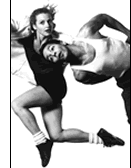|
Dance
Redefined, Page 2
An
Oberlin Genesis
The seeds of those qualities had been evident from the very beginning,
when Way arrived at Oberlin as a dance teacher in 1970. She had
been to Oberlin earlier, as a student in the 1960s, and before that
had studied in New York with George Balanchine at the School of
American Ballet.
“I worked in street theater and guerrilla dance events in downtown
New York, and I was really interested in breaking down the separation
between art and life,” Way, 59, recalls from ODC’s warren
of administrative offices one floor above the performance theater.
Light fills the high-ceilinged, narrow room, where Way sits back-to-back
with ODC General Manager Lori Laqua. “It wasn’t just about
performing in theaters, but about performance as a way of communicating
to people at large.
“I used Oberlin as a place to explore those ideas further,
so that my students could create works and perform them in Tappan
Square. We had a wonderful event in the new gymnasium, with eight
different theatrical events going on in those squash courts at the
same time and the audience walking along the bridge.”
Way also helped create an inter-arts program with faculty from the
Conservatory and the art, theater, and dance departments. Warner
Gymnasium was slated for demolition, but Way and her colleagues
persuaded then-President Robert Fuller to help them save the space.
Her previous New York experience as a Democratic committeewoman,
neighborhood organizer, and feminist informed her work both in and
out of the dance studio. “Organizing was one of the things
that I did,” she says. “So the dancers in my program were
as good at getting together a position paper as they were at creating
a dance. It was an article of faith that we could do anything. If
you wanted something to happen, you had to be part of making it
happen.”
A Golden Age bloomed in Warner, with students like actor/clown Bill
Irwin ’73, Broadway’s Julie Taymor ’74, and playwright
Eric Bogosian ’76, among many others. “People were rehearsing
in the lobby and the halls. Every room was filled. It was totally
active and inventive and creative,” says Way. Part of that
vibrant mix were Nelson and Okada, two of Way’s students who
would later become founding members of ODC.
Nelson, an engaging woman with an intent gaze and slightly husky
voice, recalls how she had taken accelerated science courses at
her Los Angeles high school and found herself “completely bored”
by her first-semester science classes at Oberlin. “I got completely
un-bored when I hit the dance floor,” she says.
“Brenda came in like a house afire and completely opened up
the definitions of dance,” says Okada, Oberlin’s first
theater/dance major. (The dance department had moved from the physical
education department to join the theater department.) “She
brought in the most remarkable people at the time—Twyla [Tharp],
Trisha Brown, Yvonne Rainier—everybody who was doing anything
interesting.”
View
Page 1 | 2
| 3 | 4
of Dance Redefined
|




